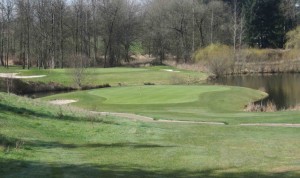Most people will tell you that reading greens is an art that can never be reduced to science. While that is mostly true, there is more science in it than you might imagine. Say you’re on an idealized green that is perfectly flat, but a bit tilted. It is entirely possible, knowing the speed of the green, the amount of its tilt, and the speed of the putt, to calculate the exact path to the hole.
In 1984, H.A. Templeton published a book titled Vector Putting, that lays out a plan which shows you how to analyze a green in just those terms. The keys are what Templeton called the zero-break line, and the gravity vector. I will explain them in a simplified, but still accurate way, retaining the term, “zero-break line”, but replacing “gravity vector” with “aiming point”.
The zero-break line is the line that follows the slope of the green straight downhill. The aiming point is the spot on this line, extended now above the hole, where you aim your putt.
Find the zero-break line on a sloping green by walking below the hole in its vicinity. You will at first sense that you are walking downhill, but when you sense you are now walking uphill, you have crossed, and thus found, the zero-break line.
The aiming point for your putt is a spot on the green on this line but on the uphill side of the hole. The precise location of this spot, as said before, depends on the speed of the green, the slope of the green, and the length of the putt.
The aiming point (the X in the diagram) will be closer to the hole along the zero-break line when: the green is slower, the slope is less, and the distance is shorter. The aiming point will be farther from the hole along the zero-break line when: the green is faster, the slope is greater, and the distance is longer. The one constant is the speed at which the ball approaches the hole.
For a 10-foot putt on a medium speed green (normal daily fee course) that slopes two degrees, the aiming point (the X on the diagram) would be six inches above the hole on the extended zero-break line. A ball putted toward this point with enough speed to finish one foot past the hole will go in the hole — regardless of where the ball is in relation to the hole. If you imagine a clock around the hole with the zero-break line running from 12 to 6, it does not matter at what o’clock the ball is. A ball 10 feet away will go in the hole if it starts out toward the aiming point with the right speed.
The chart below shows you how to find the location of the aim point on medium greens, as used in the example above. Read down the right-hand column to 10 feet, across to 2%, the slope of the green, and you will find the aim point be 6 inches above the hole along the zero-break line.
This method works best for putts of 10-12 feet or less. Over that short distance, the slope of the green is usually constant, making the green act like a tilted plane. Longer putts that might have several different breaks between the ball and the hole do not lend themselves as well to this technique. But for the shorter putts, this method is like money in the bank.
There is a refinement built into the chart, which shows you the aiming point for putts at 90 degrees to the zero-beak line. Putts like in the picture above, played from below 90 degrees, or others played from above the 90-degree line will spend a different mount of time rolling across the green.
The little numbers in the boxes show you how many inches to add for putts played from above the hole (superscript) or to subtract for putts played from below the hole (subscript), to the basic aiming point to compensate for this effect.
Play with this on the practice green. Remember, you are not trying to figure out how far outside the hole to aim your putt, but how far up the zero-break line you are aiming for. You could have one putt that would pass four inches to the side of the hole, and another one passing six inches to the side of the hole, when both times you would really be aiming at a spot ten inches above the hole on the zero-beak line.
You might also enjoy Geoff Mangum’s extended discussion of this technique.
Note from February 2022: It comes down to this. Read a putt one way and you look for the one curved path that will guide the ball into the hole. How often do you find the right path? Another way is to assess the amount of slope in the green (easy), in which direction is runs (easy), and use that information to find the spot to putt at that will carry the ball into the hole. I have much more success with #2.





